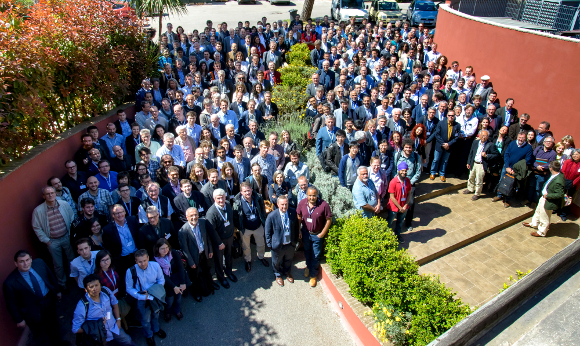
From 11 to 15 April, more than 450 participants from all over the world met in Rome during the 2016 Future Circular Collider (FCC) Week.
The future of high-energy physics on the timescale of the 21st century hinges on designing and building future colliders that could take us at least one order of magnitude beyond the present energy and intensity frontiers. Reaching this goal in an efficient way calls for a large circular collider. The FCC study explores different options for a post-LHC research infrastructure.
The discovery of the Higgs boson, a particle profoundly different from all other elementary particles, calls for further studies of its properties. Moreover, a number “known unknowns” like the observed asymmetry between matter and antimatter, the dark matter content of our Universe and the non-zero neutrino masses are only a few of the indicators that point to physics that possibly lies beyond the Standard Model. There are several questions related to physics at the TeV scale, exacerbated by the lack of evidence (so far) of new physics whose answer is critical for our understanding of the Universe.
The next results from the LHC may shatter some of our previous theories while they could call for a profound change of scientific paradigm signalling an exciting state for modern physics. Whether marked by a major discovery or not they are probably going to question our present understanding of fundamental theories. Gian Guidice, Head of CERN’s TH department in his talk “the FCC and the present physics landscape” concluded: “We live in one of the most fruitful periods in physics facing a number of challenges and new opportunities”.

With the LHC programme underway, the global particle physics community works to prepare a common vision for the future. The full exploitation of the LHC including its high-luminosity phase (HL-LHC) sets a timescale of 20 years. Given the long lead times in the field of high-energy physics, the FCC study is exploring possible options for the post-LHC era. "As one of the high-priority items on CERN's agenda, the FCC design study is exploring a potential post-LHC accelerator project that will ensure the continuation of the world’s particle physics programme” noted Frédérick Bordry, CERN Director for Accelerators and Technology. "The post-LHC accelerator calls for breakthrough technologies to afford the beam energy, intensity and brightness which are required for a future 'discovery machine'." he affirms. This timescale along with the complexity of the FCC project and the desire to profit from other international studies for future accelerators make the FCC study a timely effort.
The physics potential for each of the FCC-study scenarios (proton-proton, electron-positron or electron-proton) was reviewed during the meeting. Each of the scenarios has its specific virtues though there is also a strong complementarity while they set certain challenges for the design of the machine and the experiments. Detector-design concepts for all three scenarios were also presented while areas where further theoretical or experimental input is needed were identified. The FCC physics programme shows that this research infrastructure is not a mere follow up of past machines but could open new horizons in our quest to understand nature.
Among the main R&D programs launched as part of the FCC study are those investigating new superconducting magnets and cryogenic systems, new superconducting RF cavities, innovative vacuum systems as well as innovation in detector technologies to meet the physics challenges. The latest results in these fronts were discussed during the FCC Week 16 and the next steps in R&D activities defined.
Substantial progress has been made on infrastructure and operation studies. Civil engineering studies for a 90-100 km tunnel in the Geneva area were presented. In addition, operational aspects become crucial for FCC; controls and machine protection, as well as energy-consumption, reliability and safety were some of the topics covered during the meeting.
Finally, the FCC week also featured the work of younger researchers. More than 100 of them presented their latest research in the poster sessions. Three of them received the FCC Innovation award that distinguishes early stage researchers or engineers for outstanding work carried out in the scope of the study.
The efforts presented during the 2016 FCC week will culminate into a Conceptual Design Report by 2019. This will serve as a decision aid for a future particle research infrastructure. Michael Benedikt, FCC study leader, concluded: “We have a high responsibility to keep the present momentum and attract more collaborators in our efforts to design future circular machines that will serve the global scientific community”. Following the hard efforts of the last two years: “we must now focus on the established parameters and use them as basis for further optimization that can be done for the machines, detectors, and technologies required to realize such a large-scale research infrastructure.”
The next FCC Week will take place in Berlin from 27 May to 02 June, 2017. This meeting will mark a major review of the study and will be an important step in the launch of the preparation of the FCC Conceptual Design Report.
You can find more information about FCC and the FCC Week 2016 and read more stories in the FCC storify channel.
